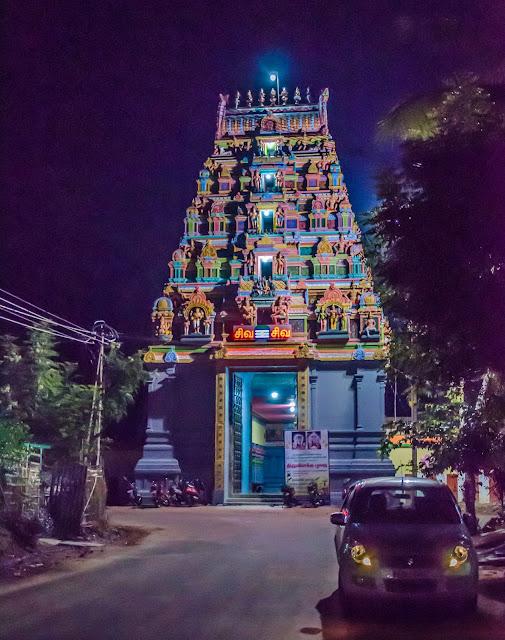The Dharumapuram Yazhmoorinathar Temple, also known as Dharmapureeswarar Temple, is a prominent Hindu shrine located in Karaikkal, Puducherry, India, now referred to as Koilpatthu. This temple is dedicated to Lord Shiva, known as Yazhmoorinathar, and his consort, Thenamirthavalli (also called Madhuraminnammai/Abhayambikai).
Significance:
It is one of the 276 Devara Paadal Petra Shiva Sthalams and ranks as the 51st Shiva Sthalam on the southern bank of the river Cauvery in Chozha Nadu (Thenkarai).
The temple features a Swayambumurthi (self-manifested) representation of Lord Shiva.
Architecture:
The temple faces east and boasts a 5-tiered Rajagopuram (main tower) and has two corridors.
Ceremonies:
The most recent Maha Kumbabishekam (consecration ceremony) was held on February 9, 2017, with a prior ceremony on April 20, 1969.
Cultural Connection:
This site is notable as the birthplace of Saint Thiru Neelakanda Yazhpanar's mother. Yazhpanar is recognized as one of the 63 Nayanmars, revered Tamil saints who contributed to the early mediaeval Thevaram poetry.
Theertham and Vriksham:
The temple features sacred waters known as Vishnu Theertham/Dharma Theertham and Brahma Theertham. The Sthala Vriksham (sacred tree) is the plantain tree, referred to as "Vazhai."
Historical Context:
The temple is celebrated in the Thevaram poems by Tamil Saivite saints, particularly Tirugnanasambandar, which underscores its spiritual significance.
Nearby, Thakkalur is recognized as one of the Devara Vaippu Sthalams, further enhancing the temple's religious and cultural importance in the region.
PURANIC SIGNIFICANCE:
Dharmapuram:
It is believed that Lord Shiva stopped Yama, the lord of Death, and punished him before he could take the life of Sage Markandeya in Thirukkadaiyur. As Yama had already thrown his noose around Sage Markandeya, he is believed to have repented for his sin by worshipping Lord Shiva here.
Yama came to this place, created a spring and performed penance. Lord Shiva granted darshan to Yama and told him that he would be restored of his position as the lord of death in due time. As Yama is also known as “Dharman”, this place gets the name Dharmapuram.
Yazh Moori Nathar:
- Another legend associated with this temple is that of a Shiva devotee by the name of Thiru Neelakanda Yazhpanar. He was a renowned musician and his preferred instrument was the “Yazh”. Yazh is a string instrument similar to the Veena or violin. Neelakanda Yazhpanar and his wife Madanga Soolamani joined Saint Thirugnana Sambandhar on his pilgrimages.
- Yazhpanar would compose the music for Sambanthar’s hymns. Since Yazhpanar was a maestro in the art of composition, a sense of arrogance rose in the minds of his relatives as they felt that Sambanthar’s popularity was mostly because of Yazhpanar’s music. Yazhpanar harboured no such thoughts and was distressed when this came to this light. He apologised to Sambandhar who readily forgave him.
- Sambandhar then expressed his desire to visit Yazhpanar’s mother and seek her blessings. For this reason, they came to Dharmapuram. However, when Sambandhar sang “Yaazhmoori Padhigam” in this temple, Yazhpanar was not able to compose music for it. In his frustration, Yazhpanar decided to break the Yazh but Sambandhar stopped him from doing so. Lord Shiva intervened, took the Yazh from Yazhpanar, composed the music for the hymn and also danced to it.
- It is for this reason that Lord Shiva of this temple is praised as “Sri Yazh Moori Nathar”. It is believed that when Lord Shiva composed the music for Sambanthar’s hymn, Goddess Parvathy sang in a voice that was “as sweet as nectar”. For this reason, she is praised as “Sri Then Amirthavalli” (“Then” means honey and “Amritam” means nectar in Tamil).
People worshipped Lord Shiva here:
It is also believed that Lord Mahavishnu, Lord Brahma and Yudhistra have worshipped the lord here. Yudhistra is also known as Dharmar. This is another reason why this place is called Dharmapuram.
Dakshinamurthy is seen in a leaning position here:
When Lord Shiva played the Yazh, it is believed that Lord Dakshinamurthy learned to enjoy the performance. For this reason, Lord Dakshinamurthy is seen in a leaning position here.
Cultural Significance
- Yazhpanar's Legacy: Thiru Neelakanda Yazhpanar, a revered musician, is celebrated for his contributions to devotional music and his close association with Saint Thirugnanasambandar during pilgrimages.
- Divine Music: The temple is famous for the divine performance of Lord Shiva, who played the Yazh while accompanied by Goddess Parvathy’s sweet voice, symbolising their harmonious union.
ADMINISTRATION:
This is one of the 27 temples that comes under the administrative control of Dharumapuram Adheenam. The last consecration ceremony (Maha Kumbabishekam) took place on 09.02.2017 and prior to that on 20.04.1969.

